Related Research Articles
John Calvin Portman Jr. was an American neofuturistic architect and real estate developer widely known for popularizing hotels and office buildings with multi-storied interior atria. Portman also had a particularly large impact on the cityscape of his hometown of Atlanta, with the Peachtree Center complex serving as downtown's business and tourism anchor from the 1970s onward. The Peachtree Center area includes Portman-designed Hyatt, Westin, and Marriott hotels. Portman's plans typically deal with primitives in the forms of symmetrical squares and circles.

SunTrust Plaza is a 265 m (869 ft) 60 story skyscraper in downtown Atlanta. Built as part of the Peachtree Center complex, construction was finished in 1992, and has been the second-tallest building in Atlanta since then. When completed, it was the 28th tallest building in the world, and 21st tallest building in the United States. Since Atlanta's tallest, the Bank of America Plaza, is located in nearby Midtown, SunTrust Plaza is the tallest in the downtown area. The light rotates.
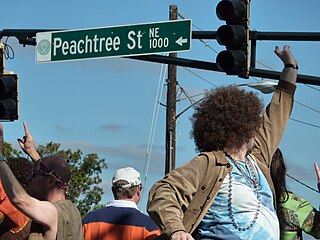
Peachtree Street is one of several major streets running through the city of Atlanta. Beginning at Five Points in downtown Atlanta, it runs North through Midtown; a few blocks after entering into Buckhead, the name changes to Peachtree Road at Deering Road. Much of the city's historic and noteworthy architecture is located along the street, and it is often used for annual parades,, as well as one-time parades celebrating events such as the 100th anniversary of Coca-Cola in 1986 and the Atlanta Braves' 1995 World Series victory.
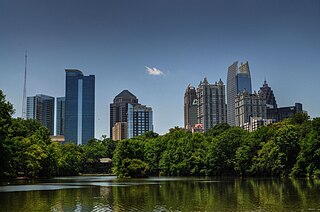
Midtown Atlanta, or Midtown, is a high-density commercial and residential neighborhood of Atlanta, Georgia. The exact geographical extent of the area is ill-defined due to differing definitions used by the city, residents, and local business groups. However, the commercial core of the area is anchored by a series of high-rise office buildings, condominiums, hotels, and high-end retail along Peachtree Street between North Avenue and 17th Street. Midtown, situated between Downtown to the south and Buckhead to the north, is the second-largest business district in Metro Atlanta. In 2011, Midtown had a resident population of 41,681 and a business population of 81,418.

Buckhead is the uptown commercial and residential district of the city of Atlanta, Georgia, comprising approximately the northernmost fifth of the city. Buckhead is the third largest business district within the Atlanta city limits, behind Downtown and Midtown, a major commercial and financial center of the Southeast.

The architecture of Atlanta is marked by a confluence of classical, modernist, post-modernist, and contemporary architectural styles. Due to the complete destruction of Atlanta by fire in 1864, the city's architecture retains no traces of its Antebellum past. Instead, Atlanta's status as a largely post-modern American city is reflected in its architecture, as the city has often been the earliest, if not the first, to showcase new architectural concepts. However, Atlanta's embrace of modernism has translated into an ambivalence toward architectural preservation, resulting in the destruction of architectural masterpieces, including the Commercial-style Equitable Building, the Beaux-Arts style Terminal Station, and the Classical Carnegie Library. The city's cultural icon, the Neo-Moorish Fox Theatre, would have met the same fate had it not been for a grassroots effort to save it in the mid-1970s.

The Margaret Mitchell House is a historic house museum located in Atlanta, Georgia. The structure was the home of author Margaret Mitchell in the early 20th century. It is located in Midtown, at 979 Crescent Avenue. Constructed by Cornelius J. Sheehan as a single-family residence in a then-fashionable section of residential Peachtree Street, the building's original address was 806 Peachtree Street. The house was known as the Crescent Apartments when Mitchell and her husband lived in Apt. 1 on the ground floor from 1925 to 1932. While living there, Mitchell wrote the bulk of her Pulitzer Prize-winning 1936 novel, Gone with the Wind.

Atlantic Station is a neighborhood on the northwestern edge of Midtown Atlanta, Georgia, United States comprising a retail district, office space, condominiums, townhomes and apartment buildings. First planned in the mid-1990s and officially opened in 2005, the neighborhood's 138 acres are located on the former brownfield site of the Atlantic Steel mill.

The Jimmy Carter Library and Museum in Atlanta, Georgia houses U.S. President Jimmy Carter's papers and other material relating to the Carter administration and the Carter family's life. The library also hosts special exhibits, such as Carter's Nobel Peace Prize and a full-scale replica of the Oval Office as it was during the Carter Administration, including a reproduction of the Resolute desk.

Downtown Atlanta is the central business district of Atlanta, Georgia, United States. The largest of the city's three commercial districts, it is the location of many corporate or regional headquarters; city, county, state and federal government facilities; Georgia State University; sporting venues; and most of Atlanta's tourist attractions. It measures approximately four square miles, and had 26,700 residents as of 2010. Similar to other central business districts in the United States, it has recently undergone a transformation that included the construction of new condos and lofts, renovation of historic buildings, and arrival of new residents and businesses.

North Avenue is an underground train station in southern Midtown Atlanta, GA, serving the Red and Gold lines of the Metropolitan Atlanta Rapid Transit Authority (MARTA) rail system. Named after the nearby North Avenue. The walls are made of white tile and painted with a mural of green hills, a blue sky, and clouds. The murals were designed by Gordon Anderson while he was a Professor of Art at Georgia State University. It is among the busiest stations in the system with an average of 15,000 boardings per weekday. The station has a direct entrance to the AT&T Midtown Center and is actually located in the skyscraper's basement.

Atlanta Peachtree Station is a train station in Atlanta, Georgia. It is currently a service stop for Amtrak's Crescent passenger train. The street address is 1688 Peachtree Road, Northwest, in the Brookwood section of town between Buckhead and Midtown.

Ponce de Leon Avenue, often simply called Ponce, provides a link between Atlanta, Decatur, Clarkston, and Stone Mountain, Georgia. It was named for Ponce de Leon Springs, in turn from explorer Juan Ponce de León, but is not pronounced as in Spanish. Several grand and historic buildings are located on the avenue.
West Midtown, also known as Westside, is a colloquial area, comprising many historical neighborhoods located in Atlanta, Georgia. Once largely industrial, West Midtown is now the location of urban lofts, art galleries, live music venues, retail and restaurants.
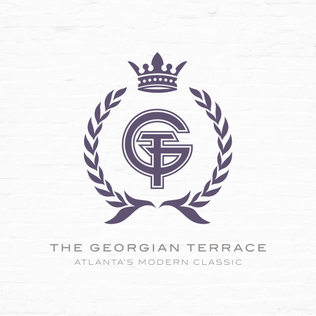
The Georgian Terrace Hotel in Midtown Atlanta, part of the Fox Theatre Historic District, was designed by architect William Lee Stoddart in a Beaux-Arts style that was intended to evoke the architecture of Paris. Construction commenced on July 21, 1910, and ended on September 8, 1911, and the hotel opened on October 2, 1911. The George C. Fuller Construction Company was contractor, and the developer was Joseph F. Gatins, Jr.

The Rufus M. Rose House is a late Victorian, Queen Anne style house located in the SoNo district of Atlanta, Georgia. Occupying a narrow lot on Peachtree Street, one and half blocks south of North Avenue, the house was built in 1901 for Dr. Rufus Mathewson Rose. The architect was Emil Charles Seiz (1873-1940), who designed many residential and commercial structures in the city, including the 1924 Massellton Apartments on Ponce de Leon Avenue.
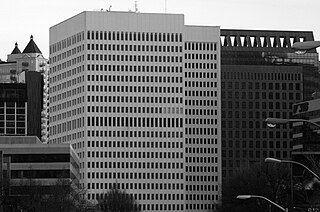
Colony Square is a mixed-use development and sub-district in Midtown Atlanta, Georgia, located on Peachtree Street in between 14th and 15th Streets. The oldest high-rise development in Midtown, the sub-district was built between 1969 and 1975, with Henri Jova of Jova/Daniels/Busby serving as principal architect. It was the first mixed-use development in the Southeast.
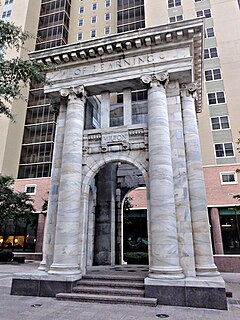
The Carnegie Education Pavilion, more often known as the Carnegie Monument, is a marble Beaux-Arts monument located in Atlanta, Georgia, United States. The pavilion was constructed in 1996 from the exterior facade of the Carnegie Library, named after Andrew Carnegie. The monument pays homage to the legacy of Carnegie by serving as a monument to higher education in Atlanta, with the seals of nine local area colleges and universities embedded in the floor of the monument. The monument was commissioned in 1996 by the Corporation for Olympic Development in Atlanta and designed by Henri Jova. The pavilion is located in Downtown's Hardy Ivy Park, at the curve in Peachtree Street where it diverges with West Peachtree Street. The monument's inscription reads: "The Advancement of Learning." It also features the inscriptions of the names of three famous Western poets "Dante", "Milton", and "Asop", in addition to the library's namesake, "Carnegie".

The Peachtree-Pine homeless shelter was located at 477 Peachtree Street NE, at the corner of Pine Street in the SoNo subdistrict of Downtown Atlanta, just south of Midtown. It was officially closed on August 28, 2017 after many years of political wrangling over the site and its management. The 100,000 square feet (9,300 m2) building, which is within sight of Fox Theatre and Bank of America Plaza, stretches from Peachtree Street in the front to Courtland Street in the back. It was run by the Metro Atlanta Task Force for the Homeless, whose executive director was Anita Beaty. The facility could house up to 700 homeless men each night, although some sources say it could house up to 1000.
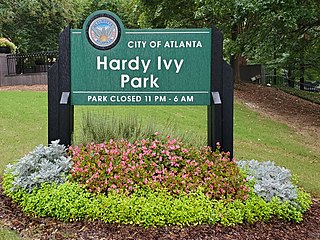
Hardy Ivy Park is a pocket park in downtown Atlanta, Georgia, United States.
References
- 1 2 3 4 5 6 "Obituary for Henri Vatable Jova", Atlanta Journal-Constitution , February 2, 2014
- ↑ Notable Alumni, Lambda Chi Alpha Fraternity at Cornell University, retrieved October 29, 2018
- ↑ Rinehart, David Roland (2009), Henri Jova: A Classical Intermezzo - An Architect's Life, Atlanta Historical Society
- 1 2 Shaw, Michelle E. (January 28, 2014), "Henri Jova, 94: Architect helped remake Midtown neighborhoods", The Atlanta Journal-Constitution
- ↑ Saporta, Maria (January 27, 2014), "Atlanta architect, Midtown savior Henri Jova dies", A0tlanta Business Chronicle